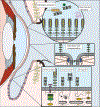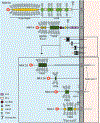Membrane-associated mucins of the human ocular surface in health and disease
- PMID: 33775913
- PMCID: PMC8328898
- DOI: 10.1016/j.jtos.2021.03.003
Membrane-associated mucins of the human ocular surface in health and disease
Abstract
Mucins are a family of high molecular weight, heavily-glycosylated proteins produced by wet epithelial tissues, including the ocular surface epithelia. Densely-packed O-linked glycan chains added post-translationally confer the biophysical properties of hydration, lubrication, anti-adhesion and repulsion. Membrane-associated mucins (MAMs) are the distinguishing components of the mucosal glycocalyx. At the ocular surface, MAMs maintain wetness, lubricate the blink, stabilize the tear film, and create a physical barrier to the outside world. In addition, it is increasingly appreciated that MAMs function as cell surface receptors that transduce information from the outside to the inside of the cell. Recently, our team published a comprehensive review/perspectives article for molecular scientists on ocular surface MAMs, including previously unpublished data and analyses on two new genes MUC21 and MUC22, as well as new MAM functions and biological roles, comparing human and mouse (PMID: 31493487). The current article is a refocus for the audience of The Ocular Surface. First, we update the gene and protein information in a more concise form, and include a new section on glycosylation. Next, we discuss biological roles, with some new sections and further updating from our previous review. Finally, we provide a new chapter on MAM involvement in ocular surface disease. We end this with discussion of an emerging mechanism responsible for damage to the epithelia and their mucosal glycocalyces: the unfolded protein response (UPR). The UPR offers a novel target for therapeutic intervention.
Keywords: Barrier function; Glycocalyx; Membrane-associated mucin; Mucosal epithelia; O-linked glycosylation; Ocular surface; Oxidative stress; Signal transduction; Unfolded protein response.
Copyright © 2021 Elsevier Inc. All rights reserved.
Figures



Similar articles
-
Membrane-associated mucins of the ocular surface: New genes, new protein functions and new biological roles in human and mouse.Prog Retin Eye Res. 2020 Mar;75:100777. doi: 10.1016/j.preteyeres.2019.100777. Epub 2019 Sep 4. Prog Retin Eye Res. 2020. PMID: 31493487 Free PMC article. Review.
-
Ocular Surface Membrane-Associated Mucins.Ocul Surf. 2016 Jul;14(3):331-41. doi: 10.1016/j.jtos.2016.03.003. Epub 2016 May 3. Ocul Surf. 2016. PMID: 27154035 Review.
-
Structure and biological roles of mucin-type O-glycans at the ocular surface.Ocul Surf. 2010 Jan;8(1):8-17. doi: 10.1016/s1542-0124(12)70213-6. Ocul Surf. 2010. PMID: 20105403 Free PMC article. Review.
-
Distribution of mucins at the ocular surface.Exp Eye Res. 2004 Mar;78(3):379-88. doi: 10.1016/s0014-4835(03)00204-5. Exp Eye Res. 2004. PMID: 15106916 Review.
-
Role of mucins in the function of the corneal and conjunctival epithelia.Int Rev Cytol. 2003;231:1-49. doi: 10.1016/s0074-7696(03)31001-0. Int Rev Cytol. 2003. PMID: 14713002 Review.
Cited by
-
Comparison of mucin levels at the ocular surface of visual display terminal users with and without dry eye disease.BMC Ophthalmol. 2023 Apr 28;23(1):189. doi: 10.1186/s12886-023-02931-3. BMC Ophthalmol. 2023. PMID: 37106448 Free PMC article.
-
The Role of Scanning Electron Microscopy in the Evaluation of Conjunctival Microvilli as an Early Biomarker of Ocular Surface Health: A Literature Review.J Clin Med. 2024 Dec 12;13(24):7569. doi: 10.3390/jcm13247569. J Clin Med. 2024. PMID: 39768491 Free PMC article. Review.
-
The Pax transcription factor EGL-38 links EGFR signaling to assembly of a cell-type specific apical extracellular matrix in the Caenorhabditis elegans vulva.bioRxiv [Preprint]. 2024 Sep 6:2024.09.04.611291. doi: 10.1101/2024.09.04.611291. bioRxiv. 2024. Update in: Dev Biol. 2025 Jan;517:265-277. doi: 10.1016/j.ydbio.2024.10.008. PMID: 39282387 Free PMC article. Updated. Preprint.
-
Epithelial barrier dysfunction in ocular allergy.Allergy. 2022 May;77(5):1360-1372. doi: 10.1111/all.15174. Epub 2021 Nov 28. Allergy. 2022. PMID: 34757631 Free PMC article. Review.
-
MUC1‑ND interacts with TRPV1 to promote corneal epithelial cell proliferation in diabetic dry eye mice by partly activating the AKT signaling pathway.Mol Med Rep. 2024 Dec;30(6):213. doi: 10.3892/mmr.2024.13337. Epub 2024 Sep 27. Mol Med Rep. 2024. PMID: 39370807 Free PMC article.
References
Publication types
MeSH terms
Substances
Grants and funding
LinkOut - more resources
Full Text Sources
Other Literature Sources
Medical

